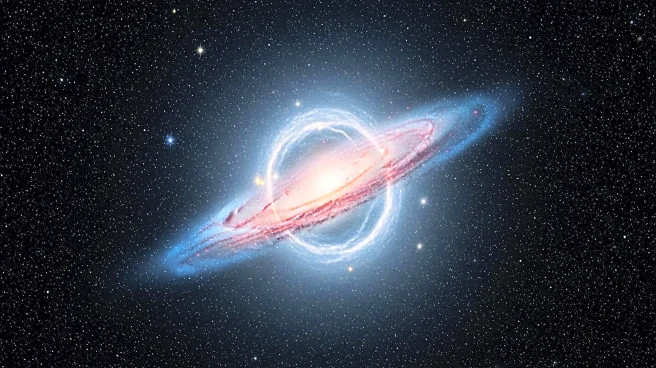What's Happening?
An international team of astronomers has utilized the Atacama Large Millimeter/submillimeter Array (ALMA) to observe the Cloverleaf quasar, leading to the serendipitous discovery of a new ultra-luminous infrared galaxy (ULIRG). This galaxy, identified at a redshift of approximately 3.39, is located about 6 arcseconds from the Cloverleaf quasar. The ULIRG boasts a molecular mass between 40 and 230 billion solar masses and a black hole mass estimated at 0.1 billion solar masses. The galaxy's total infrared luminosity is measured at 2.8 trillion solar luminosities, indicating intense star formation activity. The discovery highlights the presence of optically dark galaxies, which contribute significantly to star formation in the early universe but are challenging to detect through traditional optical surveys.
Why It's Important?
The discovery of this ultra-luminous infrared galaxy provides valuable insights into star formation and galaxy evolution in the early universe. ULIRGs are known for their intense star-forming capabilities, and understanding their properties can shed light on the processes that govern star formation and galaxy mergers. The findings suggest that the newly discovered galaxy is in the early stages of a gas-rich major merger, potentially leading to a starburst phase. This research could help refine models of galaxy evolution and the role of molecular gas in star formation, offering a deeper understanding of the universe's history and the formation of galaxies.
What's Next?
Further studies are planned to investigate the molecular gas within the newly discovered ULIRG to determine its evolutionary stage. Researchers aim to clarify the physical state of the dense molecular gas, which fuels star formation. These follow-up studies will focus on understanding whether the galaxy is transitioning through phases such as massive starburst, quasi-stellar object (QSO), or hot dust obscured galaxy (DOG), eventually evolving into an elliptical galaxy. The outcomes of these studies could provide critical insights into the lifecycle of galaxies and the mechanisms driving their evolution.
Beyond the Headlines
The discovery of optically dark galaxies like this ULIRG challenges traditional methods of galaxy detection and highlights the need for advanced observational techniques. The findings underscore the importance of submillimeter and infrared observations in uncovering hidden aspects of the universe. This research also raises questions about the role of dust and gas in obscuring galaxies, potentially influencing the way astronomers study and classify galaxies in the future.












